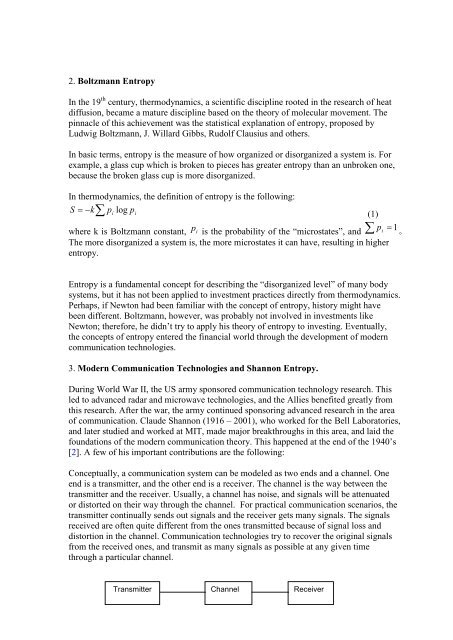Financial Signal Processing, Bubble Detection, Reflection Detection
Financial Signal Processing, Bubble Detection, Reflection Detection
Financial Signal Processing, Bubble Detection, Reflection Detection
Create successful ePaper yourself
Turn your PDF publications into a flip-book with our unique Google optimized e-Paper software.
2. Boltzmann Entropy<br />
In the 19 th century, thermodynamics, a scientific discipline rooted in the research of heat<br />
diffusion, became a mature discipline based on the theory of molecular movement. The<br />
pinnacle of this achievement was the statistical explanation of entropy, proposed by<br />
Ludwig Boltzmann, J. Willard Gibbs, Rudolf Clausius and others.<br />
In basic terms, entropy is the measure of how organized or disorganized a system is. For<br />
example, a glass cup which is broken to pieces has greater entropy than an unbroken one,<br />
because the broken glass cup is more disorganized.<br />
In thermodynamics, the definition of entropy is the following:<br />
S = −k∑<br />
p i<br />
log pi<br />
(1)<br />
where k is Boltzmann constant, p<br />
i is the probability of the “microstates”, and ∑ p i<br />
= 1<br />
。<br />
The more disorganized a system is, the more microstates it can have, resulting in higher<br />
entropy.<br />
Entropy is a fundamental concept for describing the “disorganized level” of many body<br />
systems, but it has not been applied to investment practices directly from thermodynamics.<br />
Perhaps, if Newton had been familiar with the concept of entropy, history might have<br />
been different. Boltzmann, however, was probably not involved in investments like<br />
Newton; therefore, he didn’t try to apply his theory of entropy to investing. Eventually,<br />
the concepts of entropy entered the financial world through the development of modern<br />
communication technologies.<br />
3. Modern Communication Technologies and Shannon Entropy.<br />
During World War II, the US army sponsored communication technology research. This<br />
led to advanced radar and microwave technologies, and the Allies benefited greatly from<br />
this research. After the war, the army continued sponsoring advanced research in the area<br />
of communication. Claude Shannon (1916 – 2001), who worked for the Bell Laboratories,<br />
and later studied and worked at MIT, made major breakthroughs in this area, and laid the<br />
foundations of the modern communication theory. This happened at the end of the 1940’s<br />
[2]. A few of his important contributions are the following:<br />
Conceptually, a communication system can be modeled as two ends and a channel. One<br />
end is a transmitter, and the other end is a receiver. The channel is the way between the<br />
transmitter and the receiver. Usually, a channel has noise, and signals will be attenuated<br />
or distorted on their way through the channel. For practical communication scenarios, the<br />
transmitter continually sends out signals and the receiver gets many signals. The signals<br />
received are often quite different from the ones transmitted because of signal loss and<br />
distortion in the channel. Communication technologies try to recover the original signals<br />
from the received ones, and transmit as many signals as possible at any given time<br />
through a particular channel.<br />
Transmitter Channel Receiver



